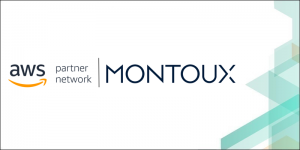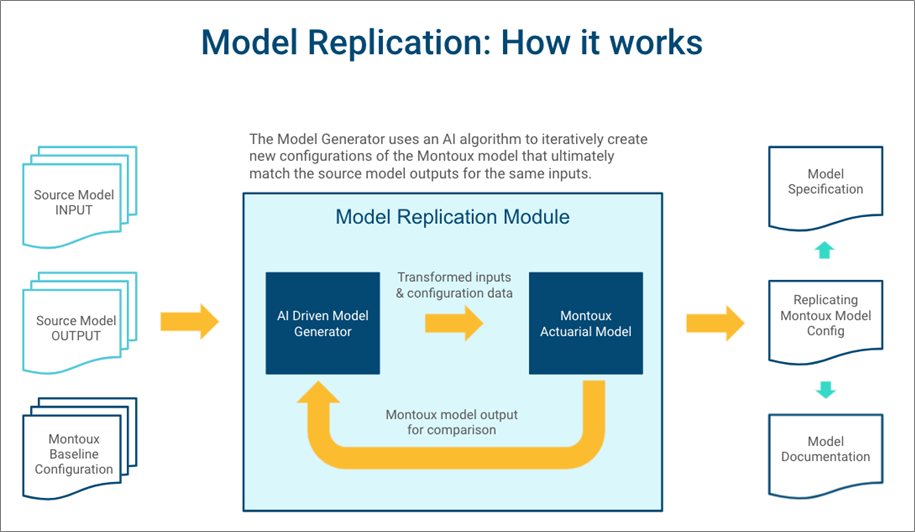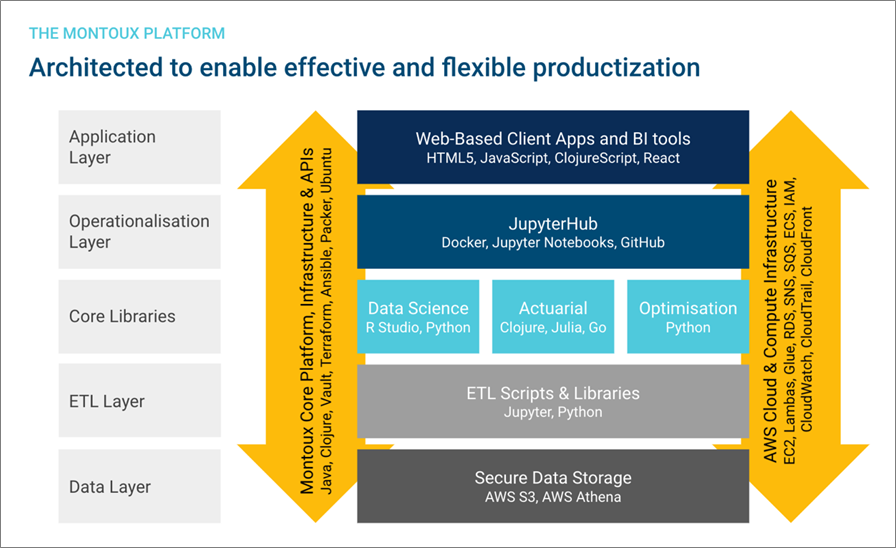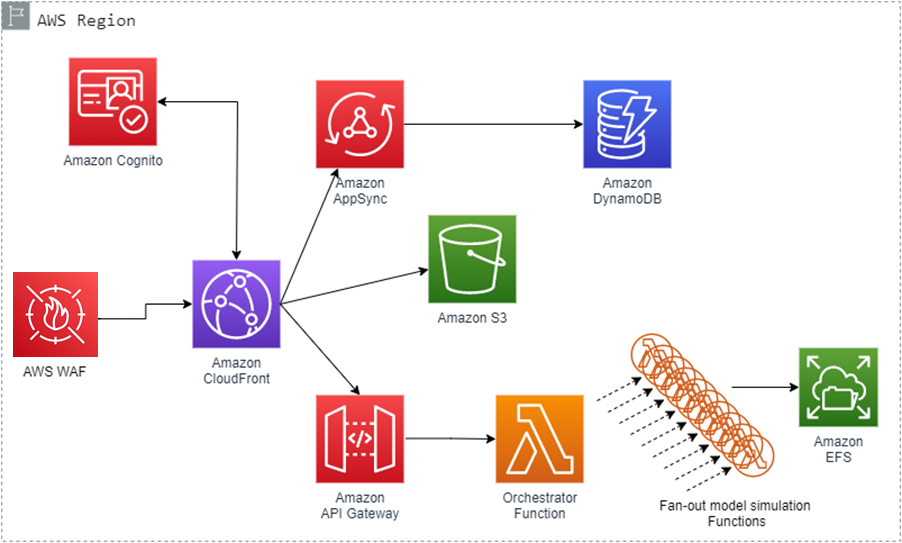AWS Partner Network (APN) Blog
Montoux’s AI-Driven Decision Science Platform Transforms Actuarial Model Replication
By Klaas Stijnen, Chief Product Officer and Co-Founder – Montoux
By Ben Meyvin, Principal Partner Solutions Architect – AWS
 |
| Montoux |
 |
The technology challenges facing life and health insurers’ actuarial teams are neither new nor a secret.
Decades-old legacy software is directly responsible for wasteful expenditure, risks, and opportunity costs, forcing carriers to search for modern alternatives to reduce costs and improve business performance.
Montoux’s next-generation decision science platform uniquely combines both actuarial and data science in its software. It provides a modern, flexible, and sophisticated alternative to legacy actuarial software.
However, the cost of migrating models from proprietary legacy platforms to a platform like Montoux’s is often considered prohibitive or limiting.
The effort required for an experienced, specialized actuary to replicate a single model is between three and 12 months, depending on model size and complexity. Life insurers typically have tens of models; more for the largest companies.
In this post, we discuss Montoux’s artificial intelligence-driven model replication module, specifically developed to support an insurer’s transition. This module reduces the time, cost, and effort required to migrate to a new platform—all enabled by serverless architecture on Amazon Web Services (AWS).
The AWS prototyping team provided direct design and implementation assistance to Montoux and played a key role in developing select platform features.
Montoux is an AWS Partner with the AWS Financial Services Competency. The decision science platform combines actuarial and data science with optimization algorithms to enable life insurers to uncover value and improve business performance.
Use Cases for AI-Driven Actuarial Model Replication
Over the past five years, Montoux has worked collaboratively with global customers to improve their technology.
After using Montoux’s first-generation platform alongside their legacy systems to improve business performance, a key challenge Montoux’s customers highlighted is the time and cost required to keep models on the Montoux platform consistent with equivalent models on legacy actuarial systems.
This cost hindered adopting Montoux’s technology across other insurance product portfolios due to reduced portfolio size, high complexity, and less strategic importance. However, these portfolios together have a significant impact on the insurer’s business performance.
Montoux responded by designing its second-generation platform to leverage artificial intelligence (AI) in order to reduce the time required to reconcile models to hours (small model changes) or days (new models).
The Model Replication Module automates two key tasks:
- Ingestion of input and output information.
- The iterative model building process using an AI algorithm.
The first component enables customers to ingest input and output data without transforming it. Instead, they can provide the schema which enables the module to interpret the input and output data.
The AI component automates the manual, repetitive process actuaries use to construct a replica of an existing actuarial model.
The model replication algorithm can create hundreds of actuarial models automatically and align with the model, providing the same output as the original when given the same input.
The algorithm can create new models by changing how actuarial functions are parameterized in a countless number of ways. For each model iteration, it evaluates whether it improved or worsened the consistency between the Montoux model and the original model, aligning with the parameterization closest to the original model.
Figure 1 – Model replication flow.
The algorithm gets close to replicating the model in sufficient detail, automating the model replication work almost completely. The actuary then needs to resolve the final replication issues; typically, unusual modelling practices which require few iterations and can be completed in days.
After sharing this capability with customers and partners, the use cases for this module expanded dramatically. Key areas where insurers and consultants can start using this module include:
- Actuarial model review and validation.
- Actuarial model development and assumption testing.
- Actuarial reporting process.
- Actuarial system consolidation.
- Mergers and acquisition.
Use Case #1: Actuarial Model Review and Validation
Model validation is an important, expensive process. Insurers write off this expense as a necessary evil due to potential costs of material errors creeping into published financials.
The model replication capability enables model validation teams and consultants to quickly and cost-effectively replicate and validate actuarial models, avoiding last-minute model changes, material errors, and restatements.
Use Case #2: Actuarial Model Development and Maintenance
Lack of model transparency creates inefficiency and ‘key person’ risk, requiring significant actuarial modelling experience and exposure to proprietary models to confidently make changes.
Actuarial teams regularly make changes to modelling and inputs, and many teams have only one actuary who understands the model well enough to confidently make changes. However, competing pressures for actuaries’ time means they can rarely review all model changes in detail, resulting in only high-level checks.
Montoux provides detailed, thorough, and fast model validation, giving actuarial teams confidence in any model changes and removing the ‘key person’ risk commonly associated with non-transparent, proprietary models.
Use Case #3: Actuarial reporting Process
Actuarial valuation teams spend most of their time running dozens or hundreds of actuarial models and collating the inputs for reporting purposes. This includes detailed runs to create key inputs on account notes or granular solvency reporting.
These runs are time intensive, with changes in the ‘base’ run forcing variation runs to be re-executed. Unexpected results are often identified late, which can trigger a complete re-run.
Replicating the key actuarial models in Montoux and using it as a shadow model to quickly produce key detailed results can prevent late-stage changes.
This capability saves life and health insurers a tremendous amount of actuarial resources. With the power of AWS Cloud and a scheduler, Montoux can execute all detailed runs automatically in a fraction of the time, saving time and making the actuarial modelling process more reliable.
Use Case #4: Actuarial System Consolidation
Many insurers use different legacy actuarial platforms, and keeping models on the different platforms in sync is inefficient and increases modelling and ‘key person’ risk. Therefore, many insurers want to reduce the number of platforms; for example, from five to two.
Migrating a model from platform to platform is a substantial investment, and often takes consultants over six months to complete. This process is dramatically accelerated with complete model transparency, provided by the model replication module.
Use Case #5: Mergers and Acquisition (M&A)
In many merger and acquisition (M&A) processes, the potential buyer of a portfolio or insurance company is presented with the inputs and results of the actuarial models, but not access to the actuarial models themselves. This challenge is unique to M&As, which are fast paced, don’t allow for the traditional model replication process, and provide limited information on the asset.
This creates buyer uncertainty, forcing them to rely on modelling executed in a seller-controlled intransparent model which estimates the asset’s market value. The buyer is therefore naturally wary of the values the modelling results present; there is no detailed explanation about how it is derived.
The buyer gains a firmer view on the asset’s market value when they understand the model generating these results. They can do this by using the model replication module to understand an asset’s market value in a timely and efficient way.
How Montoux’s Decision Science Platform Leverages AWS
Montoux’s goal was to deliver a next-generation platform capable of applying AI to substantially automate the model replication process on a global scale.
This requires a platform that:
- Automatically scales from zero to peak demands.
- Has high availability built in.
- Supports a pay-for-value billing model with optimized resource utilization.
- Is highly secure.
- Can be easily deployed globally.
- Enables integration with runtimes that provide AI algorithms.
Figure 2 – The Montoux platform.
Montoux wanted its team to focus on helping Montoux customers leverage decision science, rather than provisioning, managing, scaling and patching servers, and application infrastructure.
With AWS serverless technologies, all underlying infrastructure management tasks are handled by AWS. Agility is critically important for Montoux customers, and by eliminating operational overhead customers can release quickly, get feedback, and iterate faster.
The Montoux platform relies heavily on AWS technology to accomplish this in the following ways:
Figure 3 – Montoux serverless architecture.
- Montoux uses Amazon CloudFront to deliver its solution to global customers. Serverless end-user authentication and authorization are implemented using Lambda@Edge and Amazon Cognito. Once authenticated and authorized, the end user gets access to the model replication API and the underlying data.
- Montoux minimizes latency using Amazon API Gateway regional endpoints to deploy model replication API, and Amazon Simple Storage Service (Amazon S3) to store model data in the regions closest to its customers.
- Security is a top priority for Montoux. Amazon S3 access is restricted using an origin access identity (OAI). Amazon CloudFront and AWS Lambda authorizers restrict access to the APIs. Additionally, AWS WAF is deployed on CloudFront.
- Users can access Montoux’s model replication module through a regular web browser, with static assets served up from S3 by CloudFront. User preferences and metadata are stored in Amazon DynamoDB and are accessed by the web browser using AWS AppSync.
- Montoux uses AWS Lambda to fan out and automatically scale model replication runs under multiple actuarial assumptions and scenarios—all with zero administration. While Lambda includes a 512-MB temporary file system, this is an ephemeral scratch resource not intended for durable storage.
- Amazon Elastic File System (Amazon EFS) is built to scale on demand, growing and shrinking automatically as files are written and deleted. When used with Lambda, the code has low-latency access to a file system where the model data used to reconcile the existing and Montoux model is persisted after the function terminates.
Lambda’s fan-out approach allows for rapid iteration on model configuration against a large reconciliation dataset without having to worry about provisioning or scheduling. It enables the use of AI to perform that iterative process automatically.
The model replication module intelligently converges to the model configuration closest to the goal of reconciliation, applying a combination of learned behavior and fast-paced experimentation using the power of AWS’s computation services.
The model replication module also leverages the following services not shown on the diagram: AWS Systems Manager, AWS Key Management Service (KMS), Amazon Route 53, AWS Certificate Manager, and Amazon CloudWatch.
Summary
Montoux’s actuarial model replication module is an example of how AI technologies can be applied in an actuarial process alongside a powerful AWS serverless execution environment to significantly automate the valuable but manual, labor intensive model replication process.
We are actively interested in feedback from both actuaries and industry practitioners and are happy to work with you on a one-on-one basis to better understand your unique situation and perspective. Please contact Montoux about this post and the actuarial model replication module.
Montoux – AWS Partner Spotlight
Montoux is an AWS Competency Partner whose decision science platform for insurers combines actuarial and data science with optimization algorithms.
Contact Montoux | Partner Overview
*Already worked with Montoux? Rate the Partner
*To review an AWS Partner, you must be a customer that has worked with them directly on a project.



